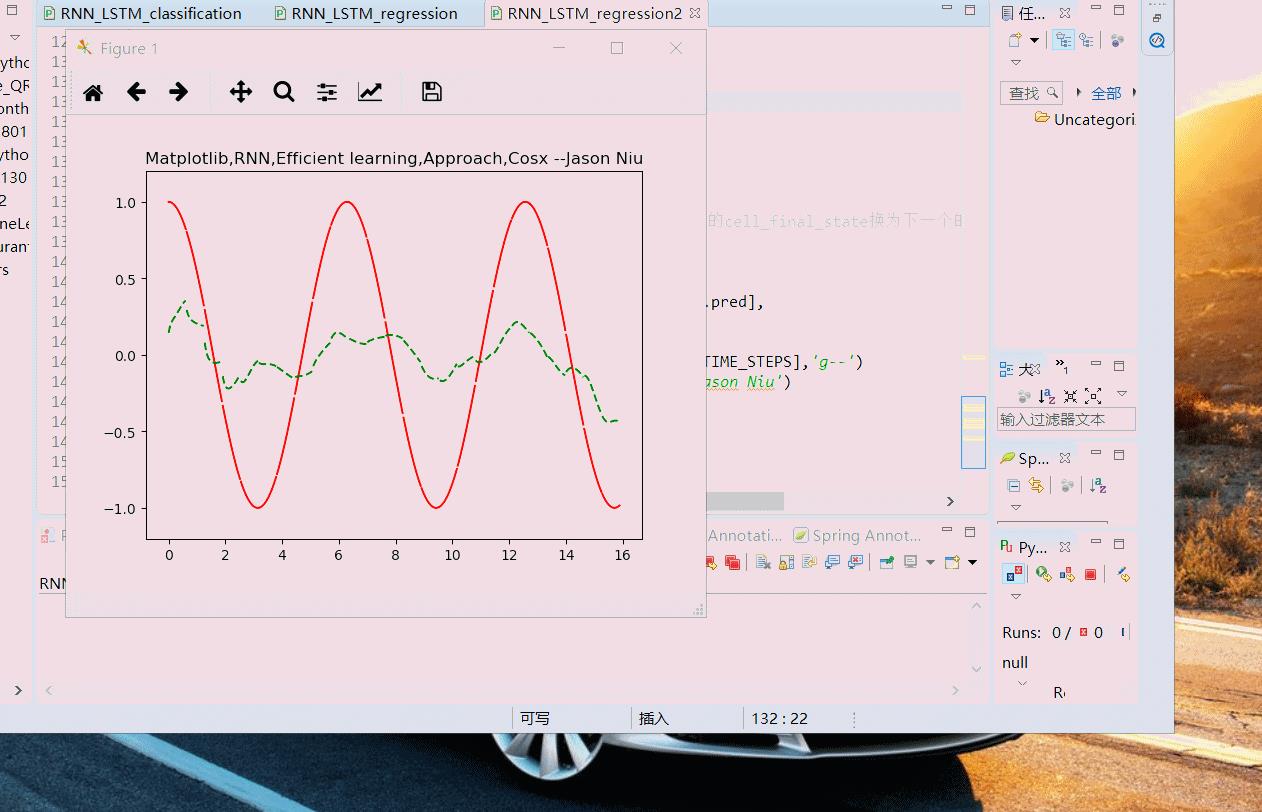TF之RNN:matplotlib动态演示之基于顺序的RNN回归案例实现高效学习逐步逼近余弦曲线—Jason niu
Posted 一个处女座的IT
tags:
篇首语:本文由小常识网(cha138.com)小编为大家整理,主要介绍了TF之RNN:matplotlib动态演示之基于顺序的RNN回归案例实现高效学习逐步逼近余弦曲线—Jason niu相关的知识,希望对你有一定的参考价值。
import tensorflow as tf
import numpy as np
import matplotlib.pyplot as plt
BATCH_START = 0
TIME_STEPS = 20
BATCH_SIZE = 50
INPUT_SIZE = 1
OUTPUT_SIZE = 1
CELL_SIZE = 10
LR = 0.006
BATCH_START_TEST = 0
def get_batch():
global BATCH_START, TIME_STEPS
# xs shape (50batch, 20steps)
xs = np.arange(BATCH_START, BATCH_START+TIME_STEPS*BATCH_SIZE).reshape((BATCH_SIZE, TIME_STEPS)) / (10*np.pi)
seq = np.sin(xs)
res = np.cos(xs)
BATCH_START += TIME_STEPS
return [seq[:, :, np.newaxis], res[:, :, np.newaxis], xs]
class LSTMRNN(object):
def __init__(self, n_steps, input_size, output_size, cell_size, batch_size):
self.n_steps = n_steps
self.input_size = input_size
self.output_size = output_size
self.cell_size = cell_size
self.batch_size = batch_size
with tf.name_scope(\'inputs\'):
self.xs = tf.placeholder(tf.float32, [None, n_steps, input_size], name=\'xs\')
self.ys = tf.placeholder(tf.float32, [None, n_steps, output_size], name=\'ys\')
with tf.variable_scope(\'in_hidden\'):
self.add_input_layer()
with tf.variable_scope(\'LSTM_cell\'):
self.add_cell()
with tf.variable_scope(\'out_hidden\'):
self.add_output_layer()
with tf.name_scope(\'cost\'):
self.compute_cost()
with tf.name_scope(\'train\'):
self.train_op = tf.train.AdamOptimizer(LR).minimize(self.cost)
def add_input_layer(self,):
l_in_x = tf.reshape(self.xs, [-1, self.input_size], name=\'2_2D\')
Ws_in = self._weight_variable([self.input_size, self.cell_size])
bs_in = self._bias_variable([self.cell_size,])
with tf.name_scope(\'Wx_plus_b\'):
l_in_y = tf.matmul(l_in_x, Ws_in) + bs_in
self.l_in_y = tf.reshape(l_in_y, [-1, self.n_steps, self.cell_size], name=\'2_3D\')
def add_cell(self):
lstm_cell = tf.nn.rnn_cell.BasicLSTMCell(self.cell_size, forget_bias=1.0, state_is_tuple=True)
with tf.name_scope(\'initial_state\'):
self.cell_init_state = lstm_cell.zero_state(self.batch_size, dtype=tf.float32)
self.cell_outputs, self.cell_final_state = tf.nn.dynamic_rnn(
lstm_cell, self.l_in_y, initial_state=self.cell_init_state, time_major=False)
def add_output_layer(self):
l_out_x = tf.reshape(self.cell_outputs, [-1, self.cell_size], name=\'2_2D\')
Ws_out = self._weight_variable([self.cell_size, self.output_size])
bs_out = self._bias_variable([self.output_size, ])
with tf.name_scope(\'Wx_plus_b\'):
self.pred = tf.matmul(l_out_x, Ws_out) + bs_out
def compute_cost(self):
losses = tf.contrib.legacy_seq2seq.sequence_loss_by_example(
[tf.reshape(self.pred, [-1], name=\'reshape_pred\')],
[tf.reshape(self.ys, [-1], name=\'reshape_target\')],
[tf.ones([self.batch_size * self.n_steps], dtype=tf.float32)],
average_across_timesteps=True,
softmax_loss_function=self.ms_error,
name=\'losses\'
)
with tf.name_scope(\'average_cost\'):
self.cost = tf.div(
tf.reduce_sum(losses, name=\'losses_sum\'),
self.batch_size,
name=\'average_cost\')
tf.summary.scalar(\'cost\', self.cost)
def ms_error(self, y_target, y_pre):
return tf.square(tf.sub(y_target, y_pre))
def _weight_variable(self, shape, name=\'weights\'):
initializer = tf.random_normal_initializer(mean=0., stddev=1.,)
return tf.get_variable(shape=shape, initializer=initializer, name=name)
def _bias_variable(self, shape, name=\'biases\'):
initializer = tf.constant_initializer(0.1)
return tf.get_variable(name=name, shape=shape, initializer=initializer)
if __name__ == \'__main__\':
model = LSTMRNN(TIME_STEPS, INPUT_SIZE, OUTPUT_SIZE, CELL_SIZE, BATCH_SIZE)
sess = tf.Session()
merged=tf.summary.merge_all()
writer=tf.summary.FileWriter("niu0127/logs0127",sess.graph)
sess.run(tf.initialize_all_variables())
plt.ion()
plt.show()
for i in range(200):
seq, res, xs = get_batch()
if i == 0:
feed_dict = {
model.xs: seq,
model.ys: res,
}
else:
feed_dict = {
model.xs: seq,
model.ys: res,
model.cell_init_state: state
}
_, cost, state, pred = sess.run(
[model.train_op, model.cost, model.cell_final_state, model.pred],
feed_dict=feed_dict)
plt.plot(xs[0,:],res[0].flatten(),\'r\',xs[0,:],pred.flatten()[:TIME_STEPS],\'g--\')
plt.title(\'Matplotlib,RNN,Efficient learning,Approach,Cosx --Jason Niu\')
plt.ylim((-1.2,1.2))
plt.draw()
plt.pause(0.1)

以上是关于TF之RNN:matplotlib动态演示之基于顺序的RNN回归案例实现高效学习逐步逼近余弦曲线—Jason niu的主要内容,如果未能解决你的问题,请参考以下文章